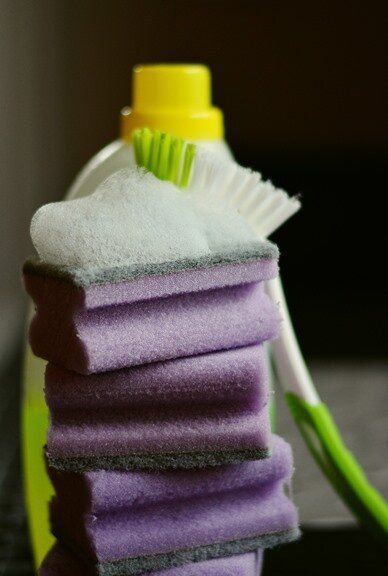Cleaning for Office Safety and Health
By Valerie Glander
While Michigan is under the “Stay home. Stay safe. Save lives” order, our OEX teams are working remotely and I am thankful for the technology that allows us to be connected even when we are not in the same building. We’re still able to be productive and share ideas through video conferencing, shared screens and phone calls. It’s just not the same, though.
We are all looking forward to the day when we can safely return to our office and showroom. The collaboration and teamwork that happens in the day-to-day activity cannot be replicated in a conference call or email. However, the emergence of the novel COVID-19 virus will certainly have a lasting impact on the way we live and work.
So, let’s talk about the basics – creating a healthy and sanitary work environment through basic cleaning practices.
Cleaning vs Disinfecting
The CDC guidelines clearly state the importance of understanding the differences between ‘cleaning’ and ‘disinfecting’ surfaces. Non-porous (hard) surfaces should be cleaned using a detergent and water prior to disinfection. This reduces the viral load on a surface and allows the disinfectant to be more effective in killing any remaining virus. The EPA has published a list of disinfectants approved for use against COVID-19 and it is available here.
Cleaning refers to the removal of dirt and impurities, including germs, from surfaces. Cleaning alone does not kill germs. But by removing the germs, it decreases their number and therefore reduces risk of spreading infection.
Disinfecting works by using chemicals to kill germs on surfaces. This process does not necessarily clean dirty surface or remove germs. But killing germs remaining on a surface AFTER cleaning further reduces the risk of spreading infection.
It’s also important to follow all instructions on detergents and disinfectants. If you’re using disinfecting wipes (like Clorox wipes), be sure to use enough wipes for the treated surface to remain visibly wet for 4 minutes.
Office Cleaning Plan
If you don’t already have a cleaning plan in place, consider following a daily / weekly / monthly checklist for ensuring a safe and sanitary environment for employees and clients. Click on the image below to download a great office cleaning checklist.
Daily
High-touch surfaces should be cleaned and disinfected daily. Think doorknobs, light switches, phone and touchscreens, work surfaces, restrooms and breakrooms.
Encourage all employees to wipe down their desks and equipment at the end of each day.
Vacuum carpeting, empty trash receptacles.
Clean breakroom counters, handles and appliances. Empty trash receptacles and spot clean walls near trash. Clean and sanitize sink.
Clean and polish drinking fountains.
Clean and disinfect all restroom fixtures, door handles and restock towels, tissue and hand soap.
Weekly
Dust all vertical surfaces, wipe down all window sills and spot clean windows.
Damp mop hard surface floors and buff as needed, taking care to get under furniture and along edges.
Monthly
Water extraction clean all carpeting and machine scrub hard surface flooring, taking care to get into corners and along edges.
Vacuum all upholstered furniture.
Perform all high dusting of light fixtures, air diffusers and doorframes.
Scour and sanitize all restroom fixtures and wash all partitions with an industry standard disinfectant.
Wash trash receptacles using a disinfectant.
Deep clean kitchen appliances and wipe all vertical surfaces in kitchen/break areas.
Clean interior and exterior windows and glass doors.
What about the soft surfaces? Commercial textiles have published cleaning guidelines readily available for your cleaning team. As we discussed in our previous blog about the high standards of the commercial textile industry, there is a great deal of testing and research about how to best clean your fabric. Be sure to follow all directions for cleaning your upholstered furniture – even task chairs. Our design team is ready to answer textile cleaning questions at interiordesign@oexusa.com.
Communication is Key
Good communication can be your first and best defense against the challenges of getting back to work after the pandemic. The CDC, many states, counties and cities have published guidelines for screening employees and visitors as well as safety recommendations for hand washing and symptom checks. It’s helpful to provide signage around the office that keeps everyone mindful of good hygiene practices as well as information regarding new policies or procedures.
Create ways for two-way communication as well – provide support and accommodation for specific needs as they arise. And remember, we are all in this together. These are uncertain times, with evolving and sometimes contradictory messages bombarding us all daily. Keep the lines of communication open by maintaining connections and practicing compassion.


